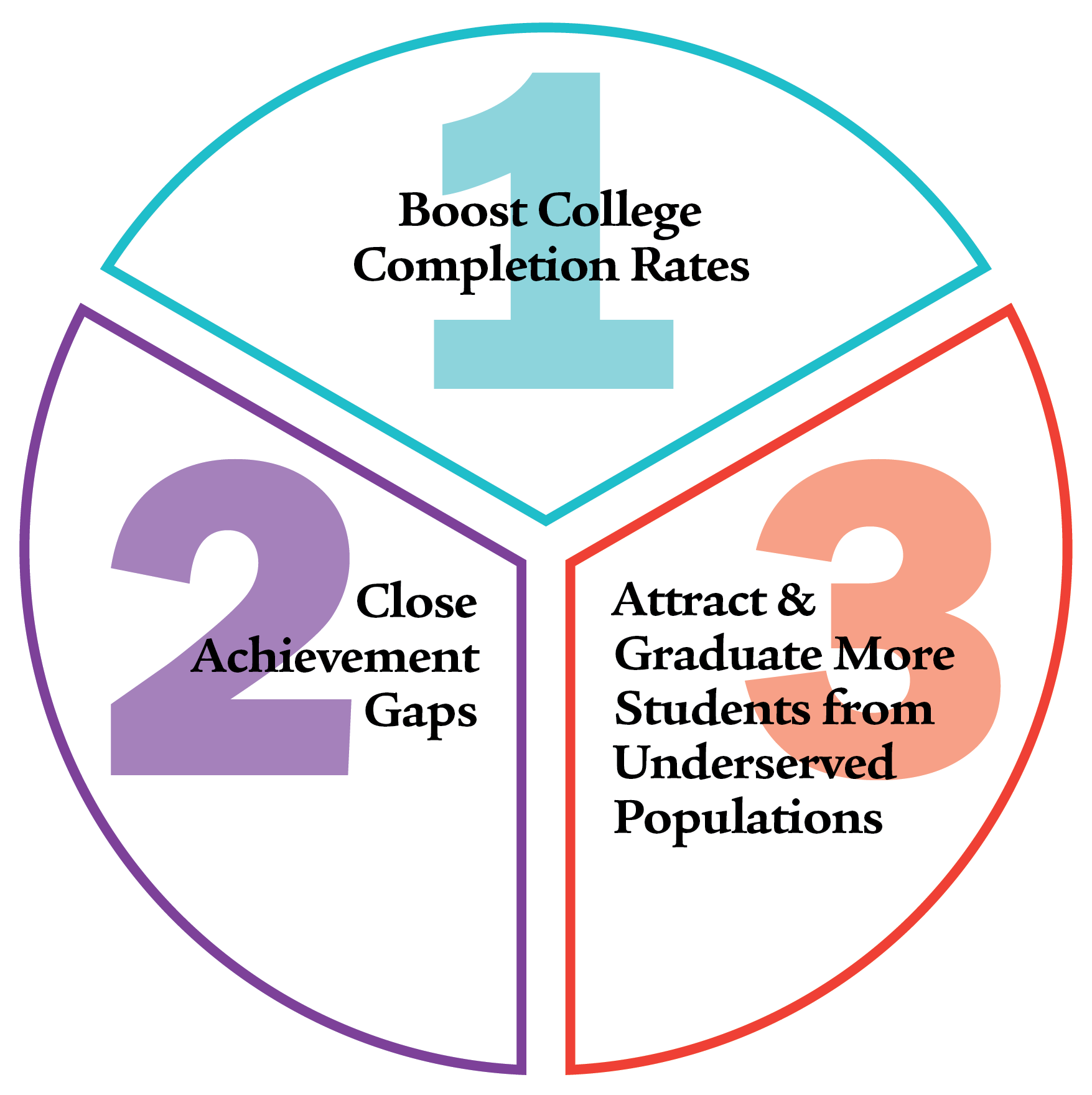
In 2014, we published the third Vision Project annual report, Degrees of Urgency. The report highlights a “perfect storm” of factors: our economy’s need for more college graduates, projected declines in the number of high school graduates, and the cumulative impact of historic underfunding of public higher education.
To heed the forecast, we are focusing our efforts on three strategies to increase the number of students graduating with degrees and certificates.
1. Boost College Completion Rates
2. Close Achievement Gaps
3. Attract and Graduate More Students from Underserved Populations
WHERE WE STAND TODAY
While 70 percent of high school graduates who attend college in state choose to “Go Public” at a community college, state university or UMass campus, not enough of them finish their studies and earn college degrees or certificates—exacerbating the degree shortfall facing the Commonwealth.
Too many students—62 percent—still arrive at our community colleges unprepared for college-level work and must take non-credit developmental (remedial) courses, which slows and often derails their progress to commencement.
Increasing interest in STEM: On the positive front, the number of STEM and Health Care-related bachelor’s degrees earned by students at MA public universities increased by 61 percent from 2007 to 2013, double the overall rate of growth in bachelor’s degrees awarded during that same period.
MOVING FORWARD
One-third of public campuses are now meeting Vision project goals. It’s time to implement their winning strategies across the entire system.
Graduating STEM majors: Currently, only 27 percent of MA public university graduates receive bachelor’s degrees in STEM and Health Care-related fields. That’s why eight public campuses are collaborating on Complete College America’s Guided Pathways to Success initiative, with all 15 community colleges lined up to adopt this national model which is producing dramatic improvements in completion rates.
Nine state universities have agreed to scale up a plan developed by Massachusetts College of Liberal Arts (MCLA) to improve student retention and college completion rates in STEM disciplines.
Student assessment: A new BHE policy based on impressive national research is allowing campuses to conduct pilot studies using high school GPA in lieu of placement exams as a measure of student readiness for college-level math, an effort to reduce the number of students assigned to developmental (remedial) coursework. They are also creating new academic “pathways” for math instruction that align more closely with different areas of study.
WHERE WE STAND TODAY
Understanding the gap: The gap between the college participation rates of African-American and White young adults has narrowed from 18 to 6 percentage points in five years.
At some public colleges and universities, achievement gaps between White and Latino/a students are starting to close, but those between White and African-American students remain largely entrenched.
MOVING FORWARD
STEM Starter Academies at Massachusetts community colleges are stimulating student interest in STEM, with particular benefit to low-income and minority students.
Strategies that work: DHE will continue to advocate for expanded funding for the Commonwealth Dual Enrollment Partnership, which gives underrepresented students a chance, while still in high school, to take college courses for free or at a reduced cost. Dual enrollment is a proven strategy for increasing college attendance and success.
Narrowing the focus: DHE, in partnership with the Departments of Early Education & Care and Elementary & Secondary Education, is launching the Massachusetts Consortium for Male Student Success to develop and implement local, regional and systemic strategies to support low-income males and males of color.
WHERE WE STAND TODAY
Adult students: Seventeen percent of all Massachusetts residents aged 25–65 have some college credit but no degree. Most of these individuals are not currently enrolled in college. Many other adults aspire to jobs that require a college degree or certificate but are not yet ready for college-level work. Once enrolled or re-enrolled, adult students persist in their studies and earn credit at lower rates than younger students, most likely due to competing family and job related pressures.
Military veterans: While the overall student vet population is soaring, the share of this population attending Massachusetts public colleges and universities declined 5 percent in the past two years.
High school graduates heading to out-of-state colleges: Thirty-three percent of college-going Massachusetts high school graduates choose to enroll out of state. Massachusetts ranks 29th in the U.S. in its retention of high school graduates, which translates into an annual loss of 20,000 potential students. If that trend were reversed, it would more than compensate for the projected decline in the high school population—and ease the state’s looming shortage of graduates.
MOVING FORWARD
We need to focus on the needs of two specific and important populations of adult students: those who have earned some college credit but remain short of obtaining an actual degree, and those who lack the basic literacy and numeracy skills to succeed at a community college.
Although the Vetearns Administration eliminated funding used to promote Post-9/11 GI Bill benefits, we must step up our outreach to the veterans’ community by building greater awareness of public college and university degree and certificate programs, especially those offered online. We must also engage veterans at military base education offices, demobilization events and through local Veterans Service Officers and the Massachusetts Department of Veterans Services.
Go Public! We must implement new enrollment and outreach strategies to encourage prospective students to remain in state, including expansion of dual enrollment and early college programs, financial aid and scholarship incentives. Meanwhile, DHE’s “Go Public!” campaign continues to promote awareness of public higher education, reaching thousands of potential students at high school events each year.